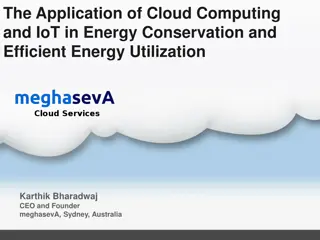Evolution of IT: Three Generations and the Impact of IoT
Understanding the evolution of Information Technology through three generations - from connecting people to computers and information on the internet to the current Internet of Things (IoT) era where computers interact without human intervention. The potential for IoT to connect computers, access information and interact with people is explored alongside challenges such as data interoperability. A cautionary tale is presented on the overarching influence of dataism in shaping a data-centric future.
Download Presentation

Please find below an Image/Link to download the presentation.
The content on the website is provided AS IS for your information and personal use only. It may not be sold, licensed, or shared on other websites without obtaining consent from the author. Download presentation by click this link. If you encounter any issues during the download, it is possible that the publisher has removed the file from their server.
E N D
Presentation Transcript
IoT George Strawn US National Academy of Sciences
Three generations of IT The Internet IoT What s the difference? A cautionary tale
Three Generations Many computers, many datasets One computer, many datasets ( the network is the computer ) One computer, one dataset (FAIR Data)
The Internet * The Internet (TCP/IP) interconnected many computerswith people attached. (Limited to billions of people.) * The three original goals were to connect people to computers, to connect people to information, and to connect people to other people. * These goals have evolved but are still here. Rlogin has evolved to apps, ftp has evolved to the Web, and smtp has evolved (devolved?) to social media.
IoT * The IoT is in process of adding many computers without people attached, but often with sensors and/or actuators, including self-driving cars and other robots. (Virtually an unlimited number of computers) * Are the additional goals of IoT to connect computers to other computers, to connect computers to information, and to connect computers to people? * Examples of these goals: connecting computers to computers my frig orders more milk; connecting computers to information remote computers send ecological data to a collection computer; connecting computers to people my front door camera tells me who is there.
Whats the difference? Computers with humans attached get to rely on human semantics to understand the data, and Internet messages send data to specific applications, which know what to expect Computers without humans have to rely on self-described data that must be able to interoperate with other data and to work with any application. Currently making data interoperable is very labor intensive. FAIR Digital Objects (FDOs) is a technology that seeks to make data objects globally accessible and sufficiently self-described to support interoperability with minimal labor and to enable computer actionability. Seems equally important for IoT and the new Open Science!
A cautionary tale: The Data Religion Homo Deus by Yuval Harari, Chapter 11 * Dataism declares that the universe consists of data flows, and the value of any phenomenon or entity is determined by its contribution to data processing. * What will be the future of the global data processing system? The Internet of All Things * In the eighteenth century, humanism sidelined God by shifting from a deo- centric to a homo-centric world view. In the twenty-first century, dataism may sideline humanity by shifting from a homo-centric to a data-centric view.
I have a seat in the IoT church But I also believe the Hamlet dictum: There are more things in heaven and earth than are dreamed of in data science























